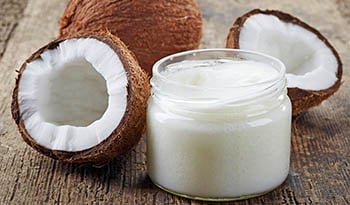Castor Oil: Benefits, History, + Anti-Inflammatory Effects
DISCLAIMER:This blog does not intend to provide diagnosis...
- In this article:
- History and Historical Uses
- Potential Medical Uses
- Join Pain and Inflammation
- Dry Eye Disease
- Castor-Oil Packs for Constipation
- Induction of Labor
- Conclusion

Castor oil is an old folk remedy with numerous uses that appears to have significant utility in helping to address a number of different conditions, from painful joints to dry eyes. And while castor oil is likely best known for its laxative properties when taken orally, using it for that is best minimized or avoided.
When ingested orally, castor oil can cause irritation and damage to the gastrointestinal tract, that allows bacteria to pass through the gastrointestinal lining and enter the body. Administering castor oil to ponies has even been used as a model for acute colitis, or severe irritation and inflammation of the colon. Moreover, long-term use of castor oil for constipation can cause electrolyte problems and dehydration.
While castor oil taken by mouth may reliably induce bowel movements, often as diarrhea, due to the harsh effects on the gastrointestinal tract, it may be best to avoid its use when possible. The availability of safer and gentler treatments for constipation—like magnesium, prunes, or fiber—is usually preferable, especially in cases where repeated, ongoing treatment is needed.
History and Historical Uses
Castor oil is derived from the seeds of the castor-oil plant Ricinus communis. Interestingly, the seeds from which the oil is derived contain one of the most lethal substances known: ricin. Fortunately, due to its structure as a protein, ricin is not fat soluble and not present in castor oil. The main constituent in the oil is the fatty acid ricinoleic acid. Castor oil is typically around 90% ricinoleic acid, with the remainder being other types of more common fatty acids.
The castor oil plant is most likely native to Africa or India, but it has naturalized to many countries due to cultivation throughout the world. The plant oil has been esteemed for both medical and industrial uses. Historically, the oil was used as a treatment for skin conditions, respiratory concerns, and gastrointestinal problems.
Potential Medical Uses
Castor oil appears to have significant anti-inflammatory effects. Research comparing the effects of capsaicin, the pungent compound that gives hot peppers their “heat,” showed significant effects in animal models. When applied topically, both castor oil and capsaicin displayed anti-inflammatory effects while also reducing swelling. The study authors concluded that ricinoleic acid (the main constituent in castor oil) could be regarded as a potential topical anti-inflammatory agent.
Other animal research has found reductions in pain with the use of topical castor oil. The activity of castor oil appears to be mediated through a compound found in the body called substance P. Substance P is a short protein, or peptide, involved in pain signaling. When applied topically, castor oil appears to disrupt substance P-based pain pathways, reducing both pain and inflammation.
Join Pain and Inflammation
Due to its anti-inflammatory and pain-reducing properties, studies have explored the use of topical castor oil for joint pain and arthritis. In a study of women with moderate to severe knee arthritis pain, daily castor oil applications followed by 5- to 10-minute applications of heat were found to reduce pain significantly. After eight days of treatment, none of the women reported severe pain, with 76% reporting only mild pain.
A separate dissertation study on postmenopausal women who had knee pain used castor oil followed by heat and also found significant benefits. At the beginning of the study, 87% of the women in the treatment group had either moderate or severe pain. After 7 days of treatment, 63% of the women reported full pain relief. Considering the ease of application and the low cost, topical castor oil could be a valuable tool for treating joint pain and deserves additional research to understand its applications better and confirm its effects.
Dry Eye Disease
Up to 34% of individuals worldwide struggle with dry eye disease (DED). The prevalence of the condition increases significantly as individuals age. When more severe, DED can interfere with sight, resulting in a significant negative impact on a person’s quality of life. Not surprisingly DED is also associated with both anxiety and depression. One of the more common causes of DED is dysfunction of the glands that stabilize the tear film layer of the eye, the meibomian glands that line the eyelids.
Although a number of treatments exist, DED is typically chronic and progressive. Lubricant eye drops, anti-inflammatories, omega-3 fats, and hot compresses, among other treatments, are often utilized.
Interestingly, castor oil appears to be another potential treatment that may reduce symptoms of DED. An initial study used a low-concentration castor oil eye drop and found significant improvements in patients with meibomian gland dysfunction. A separate trial explored a combination of castor oil in lubricant eye drops and found improvements in tear evaporation and tear quality with castor oil over just lubricant eye drops alone.
Blepharitis is inflammation of the eyelids. A study exploring the application of castor oil to the inflamed eyelid found significant benefits with the treatment. In the study, the authors concluded that castor oil may be a potential therapeutic option for patients with blepharitis.
A review of the use of castor oil for DED concluded that castor oil is both safe and well tolerated. The oil improves symptoms, likely due to anti-inflammatory, antimicrobial, and lipid-film-enhancing properties.
Castor-Oil Packs for Constipation
Castor oil packs are a popular alternative treatment that have been utilized for abdominal and gastrointestinal conditions. The treatment typically involves a castor-oil-saturated piece of flannel cloth applied to the abdomen, covered by a layer of plastic and a hot water bottle. The heat is left in place for 30 to 60 minutes to drive the castor oil deeper into the tissues. Historically, castor oil packs are often prescribed for supporting the liver, gastrointestinal issues, and menstrual cramps.
While a number of natural options can be helpful for constipation, castor oil packs may also have a place in treatment. Constipation is a common problem, occurring in 10%–15% of the population, with incidence increasing as people age. A small study of elderly subjects living in a care home found benefits with castor oil packs for constipation. Of the study participants, 80% had been suffering with constipation for 10 or more years. Castor oil packs were applied daily for three days. The treatments softened patients’ stools, making them easier to pass with less straining. Additionally, the treatment did not cause urgent diarrhea, a significant advantage over oral laxatives, especially given that many of the patients needed assistance to reach the bathroom. Based on the initial findings, the authors also hypothesized that longer treatment might have provided further benefits.
Induction of Labor
Finally, data suggest that castor oil may be effective for inducing labor. When a pregnancy is past due, interventions are often applied to artificially induce labor and start the birthing process. However, standard medical interventions increase the risk of infection in both the mother and child. Standard medical interventions can also cause abnormal contractions, leading to an increased need for other higher-level interventions to facilitate birth.
Castor oil has been studied as a safer approach to stimulate labor. To induce labor, a single oral dose of castor oil is administered. The oil is thought to cause the release of prostaglandins, signaling molecules that can promote labor induction, along with causing increased uterine contractions. Research suggests that castor oil can facilitate labor while reducing the need for Cesarean sections. Studies have concluded that castor oil is a safer approach for labor induction than other standard techniques, potentially improving outcomes and reducing higher-level medical interventions. Even so, castor oil should only be used to induce labor under a doctor’s supervision and should not be taken orally earlier in pregnancy.
Conclusion
Castor oil is an old folk remedy that may have significant benefits for a number of different conditions. The oil appears to be anti-inflammatory and antimicrobial, providing benefits when applied topically with heat for knee pain. Significant research also suggests benefits for dry and irritated eyes with castor oil formulations. Additionally, castor oil packs may help normalize bowel movements in constipation patients. And finally, castor oil may be safer for inducing labor when pregnancies have extended past term.
References:
- Arslan GG, Eşer I. An examination of the effect of castor oil packs on constipation in the elderly. Complement Ther Clin Pract. 2011;17(1):58-62. doi:10.1016/j.ctcp.2010.04.004
- Cassia Jemi, C. A quasi experimental study to evaluate the effectiveness of castor oil massage with hot fomentation on knee joint pain among post menopausal women at selected community areas in Pudukkottai District. Masters thesis, 2018. Karpaga Vinayaga College of Nursing, Pudukkottai.
- DeMaria AL, Sundstrom B, Moxley GE, Banks K, Bishop A, Rathbun L. Castor oil as a natural alternative to labor induction: A retrospective descriptive study. Women Birth. 2018;31(2):e99-e104. doi:10.1016/j.wombi.2017.08.001
- Final report on the safety assessment of Ricinus communis (castor) seed oil, hydrogenated castor oil, glyceryl ricinoleate, glyceryl ricinoleate se, ricinoleic acid, potassium ricinoleate, sodium ricinoleate, zinc ricinoleate, cetyl ricinoleate, ethyl ricinoleate, glycol ricinoleate, isopropyl ricinoleate, methyl ricinoleate, and octyldodecyl ricinoleate. Int J Toxicol. 2007;26 Suppl 3:31-77. doi:10.1080/10915810701663150
- Khanal S, Tomlinson A, Pearce EI, Simmons PA. Effect of an oil-in-water emulsion on the tear physiology of patients with mild to moderate dry eye. Cornea. 2007;26(2):175-181. doi:10.1097/ICO.0b013e31802b492d
- Messmer EM. The pathophysiology, diagnosis, and treatment of dry eye disease. Dtsch Arztebl Int. 2015;112(5):71-82. doi:10.3238/arztebl.2015.0071
- Morehouse JL, Specian RD, Stewart JJ, Berg RD. Translocation of indigenous bacteria from the gastrointestinal tract of mice after oral ricinoleic acid treatment. Gastroenterology. 1986;91(3):673-682. doi:10.1016/0016-5085(86)90638-4
- Muntz A, Sandford E, Claassen M, et al. Randomized trial of topical periocular castor oil treatment for blepharitis. Ocul Surf. 2021;19:145-150. doi:10.1016/j.jtos.2020.05.007
- Naik B. Botanical Descriptions of Castor Bean. In: Kole C, Rabinowicz P. eds. The Castor Bean Genome. Compendium of Plant Genomes. Springer, Cham; 2018. https://doi.org/10.1007/978-3-319-97280-0_1
- Roberts MC, Clarke LL, Johnson CM. Castor-oil induced diarrhoea in ponies: a model for acute colitis. Equine Vet J Suppl. 1989;(7):60-67. doi:10.1111/j.2042-3306.1989.tb05658.x
- Roopa SD, Sahbanathul MA. Effectiveness of castor oil massage with hot application on knee joint pain among women. IJIRT. 2015;2(4):73-76.
- Sandford EC, Muntz A, Craig JP. Therapeutic potential of castor oil in managing blepharitis, meibomian gland dysfunction and dry eye. Clin Exp Optom. 2021;104(3):315-322. doi:10.1111/cxo.13148
- Scarpa A, Guerci A. Various uses of the castor oil plant (Ricinus communis L.). A review. J Ethnopharmacol. 1982;5(2):117-137. doi:10.1016/0378-8741(82)90038-1
- Vieira C, Evangelista S, Cirillo R, et al. Antinociceptive activity of ricinoleic acid, a capsaicin-like compound devoid of pungent properties. Eur J Pharmacol. 2000;407(1-2):109-116. doi:10.1016/s0014-2999(00)00727-5
- Vieira C, Evangelista S, Cirillo R, Lippi A, Maggi CA, Manzini S. Effect of ricinoleic acid in acute and subchronic experimental models of inflammation. Mediators Inflamm. 2000;9(5):223-228. doi:10.1080/09629350020025737

 By Dr. Scott Buesing, N.D.
By Dr. Scott Buesing, N.D.


